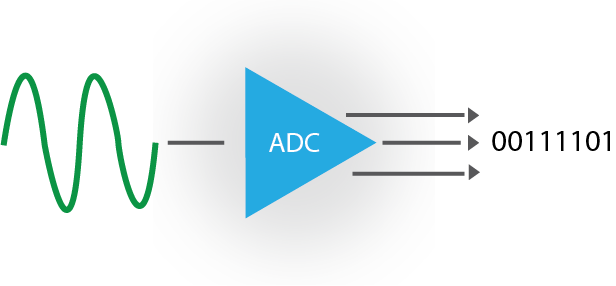

Examples of analogue signals include temperature, pressure, liquid levels and light intensity.įor a digital circuit the potentiometer wiper has been replaced by a single rotary switch which is connected in turn to each junction of the series resistor chain, forming a basic potential divider network. As the potentiometers wiper is adjusted from one position to the next, there is no sudden or step change between the two voltage levels thereby producing a continuously variable output voltage. Here we can see that as the wiper terminal of the potentiometer is rotated between between 0 volts and V MAX, it produces a continuous output signal (or voltage) which has an infinite number of output values relative to the wiper position. Thus an analogue to digital converter takes an unknown continuous analogue signal and converts it into an “n”- bit binary number of 2 n bits.īut first let us remind ourselves of the differences between an analogue (or analog) signal and a digital signal as shown: Analogue and Digital Signals The number of binary digits, or bits used to represent this analogue voltage value depends on the resolution of an A/D converter.įor example a 4-bit ADC will have a resolution of one part in 15, (2 4 – 1) whereas an 8-bit ADC will have a resolution of one part in 255, (2 8 – 1).

#Analog to digital converter calculator code#
So it is necessary to have an electronic circuit which can convert between the two different domains of continuously changing analogue signals and discrete digital signals, and this is where Analogue-to-Digital Converters (A/D) come in.īasically an analogue to digital converter takes a snapshot of an analogue voltage at one instant in time and produces a digital output code which represents this analogue voltage.

While analogue signals can be continuous and provide an infinite number different voltage values, digital circuits on the other hand work with binary signal which have only two discrete states, a logic “1” (HIGH) or a logic “0” (LOW). In the real world, analogue signals have continuously changing values which come from various sources and sensors which can measure sound, light, temperature or movement, and many digital systems interact with their environment by measuring the analogue signals from such transducers. Analogue-to-Digital Converters, (ADCs) allow micro-processor controlled circuits, Arduinos, Raspberry Pi, and other such digital logic circuits to communicate with the real world.


 0 kommentar(er)
0 kommentar(er)
